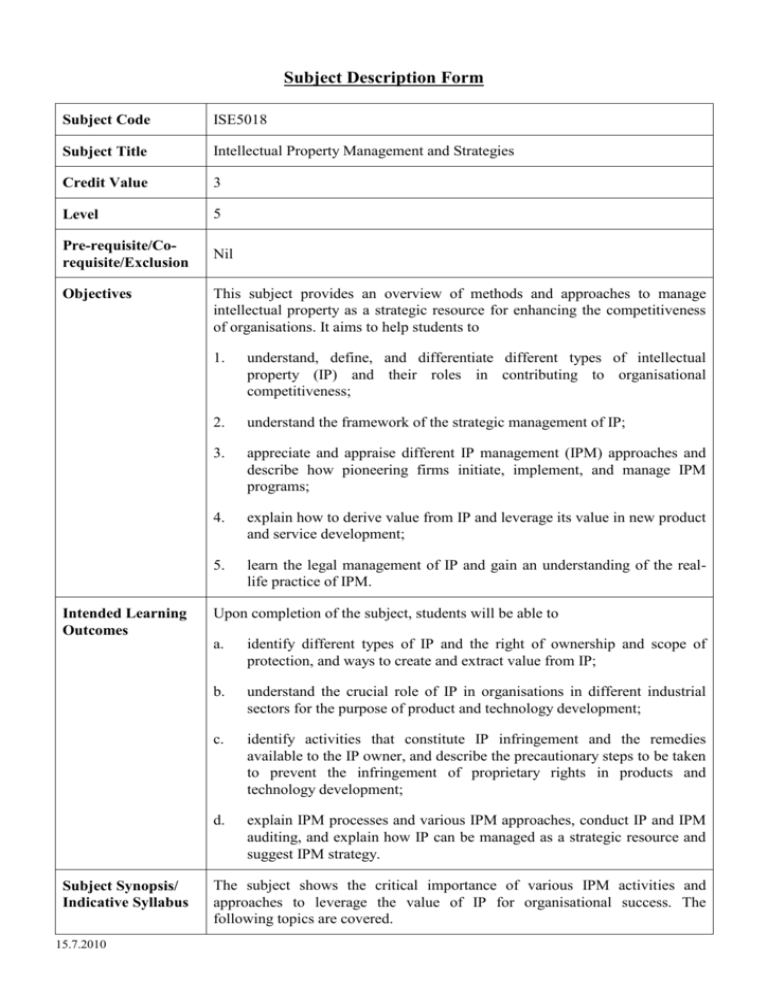ISE5018: Intellectual Property Management and Strategies
advertisement

Subject Description Form Subject Code ISE5018 Subject Title Intellectual Property Management and Strategies Credit Value 3 Level 5 Pre-requisite/Corequisite/Exclusion Nil Objectives Intended Learning Outcomes Subject Synopsis/ Indicative Syllabus 15.7.2010 This subject provides an overview of methods and approaches to manage intellectual property as a strategic resource for enhancing the competitiveness of organisations. It aims to help students to 1. understand, define, and differentiate different types of intellectual property (IP) and their roles in contributing to organisational competitiveness; 2. understand the framework of the strategic management of IP; 3. appreciate and appraise different IP management (IPM) approaches and describe how pioneering firms initiate, implement, and manage IPM programs; 4. explain how to derive value from IP and leverage its value in new product and service development; 5. learn the legal management of IP and gain an understanding of the reallife practice of IPM. Upon completion of the subject, students will be able to a. identify different types of IP and the right of ownership and scope of protection, and ways to create and extract value from IP; b. understand the crucial role of IP in organisations in different industrial sectors for the purpose of product and technology development; c. identify activities that constitute IP infringement and the remedies available to the IP owner, and describe the precautionary steps to be taken to prevent the infringement of proprietary rights in products and technology development; d. explain IPM processes and various IPM approaches, conduct IP and IPM auditing, and explain how IP can be managed as a strategic resource and suggest IPM strategy. The subject shows the critical importance of various IPM activities and approaches to leverage the value of IP for organisational success. The following topics are covered. 1. Basic IP Concepts Types of IP, the right of ownership and scope of protection, value creation and value extraction via IP, legal aspects of IP, including application, appropriation, infringement, design around, and licensing. 2. IP Management Strategies and Implementation Overview of IP management and strategy, IP management audit, patent portfolio and patent intelligence, technology strategy and patent analysis, patent dispute management and strategy, co-opetition, IP strategy, and the open business model, IP valuation, royalty and damages. 3. Case Studies Case studies are drawn from commercial, industrial, legal, and technological cases of product and technology development. Teaching/Learning Methodology Assessment Methods in Alignment with Intended Learning Outcomes This subject is offered in block mode format at the weekends, usually spread over a month. A mixture of lectures, tutorial exercises, and case studies is used to deliver the various topics in this subject. Some material is delivered using a problem-based format where this advances the learning objectives. Other material is covered through directed study to enhance students’ “learning to learn” ability. A mini-project is used to integrate these topics and demonstrate to students how various techniques are interrelated and applied in real-life situations. The cross fertilisation of the ideas and experiences of students is encouraged through discussions and presentations. Specific assessment methods/tasks % Intended subject learning outcomes to be assessed weighting a b c d 1. Individual assignments 30% 2. Group mini-project proposal 10% 3. Short quiz 10% 4. Open-book test 25% 5. Group mini-project 25% Total 100% Continuous assessment comprises individual and group assignments, a miniproject, a short quiz, and a test. All assessment components require students to apply what they have learnt to realistic work scenarios. To enhance students’ understanding of the topics covered in learning outcomes 15.7.2010 (c) and (d), an individual assignment is given which allows students to apply IPM theory and concepts to address real-life problems. The mini-project proposal allows students to identify different kinds of IP and IPM problems in organisations (learning outcome (a)) and develop their skills through formulating a plan to address the problems (learning outcome (d)). The short quiz aims to assess the understanding of students of the topics covered in learning outcomes (a) and (b). The mini-project is designed to assess the ability of students to integrate and apply the concepts, theory, methods, and approaches to manage IP as a strategic resource for enhancing the competitiveness of organisations (learning outcomes (a) to (d)). An open-book test is administered, which assesses the students’ ability to apply the theory and concepts learnt in the course to analysing and solving problems related to the subject (learning outcomes (a) to (d)). Student Study Effort Expected Class contact: Lectures 28 Hrs. In-class activities/Tutorials/Laboratory work 14 Hrs. Other student study effort: Study and self-learning including the mini-project and preparation for the mini-project presentation 42 Hrs. Assignment and report writing 28 Hrs. Total student study effort Reading List and References 15.7.2010 112 Hrs. 1. Cornish, William Rodolph & Llewelyn, David. 2007, Intellectual Property: Patents, Copyright, Trade Marks and Allied Right, 6th edn, Sweet & Maxwell 2. Cornish, William Rodolph. 2006, Cases and Materials on Intellectual Property, 5th edn, Sweet & Maxwell 3. Dreyfus, Rochelle Cooper and Kwall, Roberta Rosenthal. 1996, Intellectual Property: Cases and Materials on Trademark, Copyright and Patent Law, Foundation Press 4. Lo, Jack and Pressman, David. 2007, How to Make Patent Drawings: A Patent It Yourself Companion, 5th edn, Nolo 5. Pendleton, Michael D. & Lee, Alice S. C. 2001, Intellectual Property: A Guide to the Law in Hong Kong (with reference to the developments in China), Butterworths Asia 6. Wong, Kenny K. S. & Lee, Alice S. C. 2002, A Practical Approach to Intellectual Property Law in Hong Kong, Sweet & Maxwell 15.7.2010 7. Sullivan, P.H. 2000, Value-Driven Intellectual Capital: How to Convert Intangible Corporate Assets into Market Value, John Wiley & Sons, Inc., Hoboken, New Jersey 8. Al-Ali N. 2003, Comprehensive Intellectual Capital Management: Stepby-Step, John Wiley & Sons, Inc. Hoboken, New Jersey









